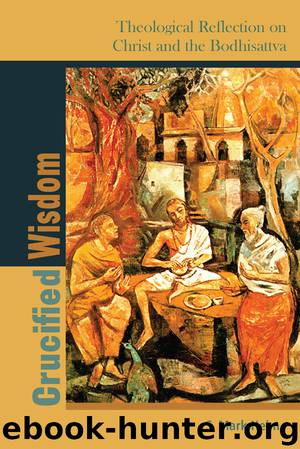Crucified Wisdom by S . Mark Heim

Author:S . Mark Heim
Language: eng
Format: epub
Publisher: Fordham University Press
6 How Do Buddhas Help?
BODHISATTVA AS BENEFACTOR AND CHRIST AS SAVIOR
The practical similarity between Christ/disciples and Buddhas/bodhisattvas is their orientation toward others, their unrestricted compassion. To attain enlightenment for the sake of all sentient beings is by definition to be a helper to all beings. Throughout the Buddhist world, suffering beings address their appeals to bodhisattvas and look to them for aid. In this chapter, we turn to these simple questions: How do bodhisattvas help? And how might reflection on that helping inform Christian theology?
Many Faces of Compassion
So far, we have not focused on any particular bodhisattva. The teachings that we have reviewed suggest that there is only one bodhisattva path and that bodhisattva-Buddhas could not differ from one another in their nondual realization. But the characteristic form of the bodhisattva is precisely as a helper, and such helpers come in different guises. One of the most famous is the bodhisattva Avalokiteśvara, the “Lord who regards the cries of the world.” This figure appears in Chapter 25 of the Lotus Sutra, arising as a roughly chronological contemporary to Jesus and the gospels.1 The Buddha explains this title by saying that if numberless billions of beings in suffering and agony were to call Avalokiteśvara’s name, he would “immediately hear their cries and all of them would be freed.”2 This applies to concrete worldly needs, whether they be the attack of robbers or the desire to bear a son. If someone, guilty or not, is imprisoned, then her bonds will be broken if she calls on this name.3 This bodhisattva is a prime example of the skillful-means/one-vehicle theme of the Lotus Sutra. He appears in more diverse forms than any other bodhisattva, taking whatever status is required—that of a monk, a woman, a child, or a deity.4
In the Lotus Sutra, he is one of many bodhisattva figures. But as Mahāyāna Buddhism spread from India, his prominence grew. This change came most decisively after the transition to China and East Asia. A key aspect was a shift in gender that took place around 900 CE in the northwest Chinese end of the Silk Road.5 Avalokiteśvara became Kuan Yin (or, in Japan, Kannon), the preeminent object of appeal and representation of mercy in Buddhist religious life in these cultures. Kuan Yin assumes many forms herself. The most common catalog of these lists thirty-three, each responsive to particular conditions such as childbirth or peril at sea.6 With the concrete figure of Kuan Yin, we come much closer to the texture of bodhisattvas in ordinary Buddhist life. Her benefits and assistance are sought by virtually all, not only those who in their lifetimes vow to take up the organized pursuit of the bodhisattva perfections.
Just as the Jataka tales retrospectively outline Gautama’s bodhisattva path, Kuan Yin acquired her backstories, as well. One of the most popular accounts says that Kuan Yin was once a princess named Miao Shan.7 If Miao Shan belongs to Avalokiteśvara’s family tree on the ascending bodhisattva path, then she also has a pedigree on the other, “descending” side, as well.
Download
This site does not store any files on its server. We only index and link to content provided by other sites. Please contact the content providers to delete copyright contents if any and email us, we'll remove relevant links or contents immediately.
| Acupuncture & Acupressure | Aromatherapy |
| Ayurveda | Chelation |
| Chinese Medicine | Energy Healing |
| Healing | Herbal Remedies |
| Holistic | Homeopathy |
| Hypnotherapy | Massage |
| Meditation | Naturopathy |
| Reference |
Inner Engineering: A Yogi's Guide to Joy by Sadhguru(5897)
The Power of Now: A Guide to Spiritual Enlightenment by Eckhart Tolle(4756)
Fear by Osho(4085)
The Art of Happiness by The Dalai Lama(3385)
The Ultimate Bodybuilding Cookbook by Kendall Lou Schmidt(3320)
Yoga Therapy by Mark Stephens(3222)
Ikigai by Héctor García & Francesc Miralles(3144)
The Little Book of Hygge by Meik Wiking(3081)
Why Buddhism is True by Robert Wright(2827)
The Healing Self by Deepak Chopra(2796)
Being Aware of Being Aware by Rupert Spira(2708)
Shift into Freedom by Loch Kelly(2692)
Wild Words from Wild Women by Stephens Autumn(2589)
Work Clean by Dan Charnas(2562)
Happiness by Matthieu Ricard(2524)
The Hatha Yoga Pradipika (Translated) by Svatmarama(2484)
Yoga Body & Mind Handbook by Jasmine Tarkeshi(2465)
More Language of Letting Go: 366 New Daily Meditations by Melody Beattie(2444)
Why I Am Not a Feminist by Jessa Crispin(2239)
